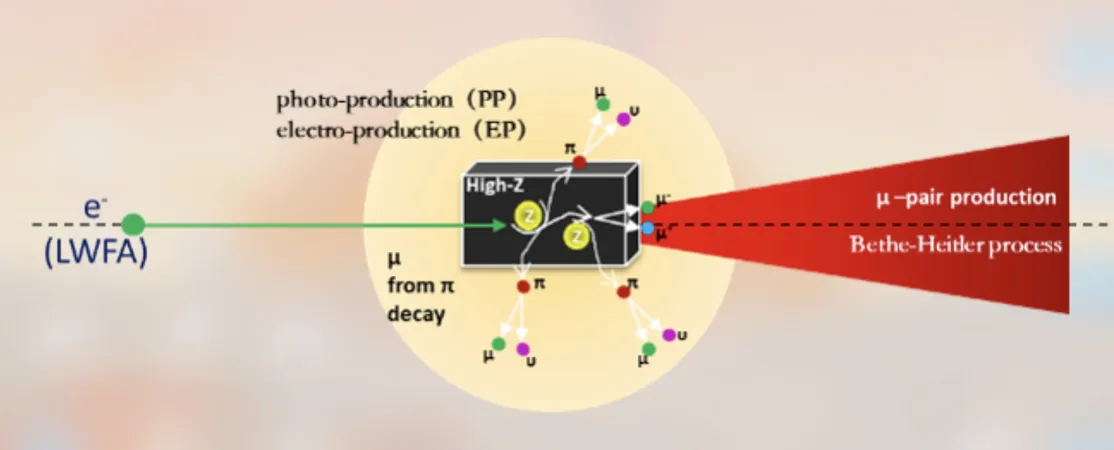
Revolutionary Laser Technique Unlocks New Potential for Muon Generation
2025-05-29
Author: Arjun
The Fascinating World of Muons
Muons, intriguing elementary particles akin to heavier cousins of electrons, hold immense potential in the realm of physics. Despite their fleeting lifetimes—decaying in mere microseconds—their study could challenge and enrich our understanding of particle physics.
Legacy Methods vs. Innovative Approaches
Traditionally, generating muons has relied on massive, costly proton accelerators or the unpredictable cosmic rays from outer space. Now, a groundbreaking study from researchers at the China Academy of Engineering Physics and other institutions has unveiled a game-changing method: creating muons using ultra-short, high-intensity lasers.
Groundbreaking Discoveries Published in Nature Physics
In a landmark paper featured in Nature Physics, the researchers detailed their successful technique, achieving an impressive yield of up to 0.01 muons per incoming electron. Yuqiu Gu, a co-author, emphasized the revolutionary nature of this approach, especially given the limitations of traditional muon generation methods.
How It Works: High-Energy Electron Interactions
Harnessing advanced laser amplification techniques, the team initiated high-energy electron interactions with a conversion target—marking the first instance of muon generation within a laser laboratory. The intricate process involves secondary radiation interactions, making the confirmation of muons a complex endeavor.
New Detection Methods: Tracking Muons Like Never Before
To verify their findings without overwhelming interference from secondary radiations, the researchers ingeniously measured muons' rest decay lifetime. This unique approach allowed them to distinguish muons from other particles with confidence, leading to groundbreaking experimental results.
Promising Results and Future Prospects
The initial experiments revealed striking results, with the lifetime spectrum of the generated particles aligning perfectly with known muon behaviors. Gu acknowledged their milestone: "We generated a muon source for the first time at a laser laboratory, achieving a yield of 0.01 μ/e. This one experiment holds the potential to release up to 107 muons per shot!"
Empowering Smaller Labs for Muon Research
This innovative muon source paves the way for smaller laboratories to engage in advanced muon-related research. Applications like high-energy muon radiography and other cutting-edge studies are now within closer reach, significantly lowering the barriers to entry.
What Lies Ahead: Exploring New Frontiers in Physics
Looking forward, the team plans to delve deeper into the energy spectrum and angular distribution of their muon source. Plans are underway to explore various applications ranging from muon point projection radiography to all-optical muon acceleration.
A New Era in Particle Physics Research
This revolutionary advancement in muon generation not only signifies a leap in particle physics but also opens an exhilarating chapter in scientific exploration. As researchers continue to harness the power of laser technology, the future of muon-related research looks brighter than ever.



 Brasil (PT)
Brasil (PT)
 Canada (EN)
Canada (EN)
 Chile (ES)
Chile (ES)
 Česko (CS)
Česko (CS)
 대한민국 (KO)
대한민국 (KO)
 España (ES)
España (ES)
 France (FR)
France (FR)
 Hong Kong (EN)
Hong Kong (EN)
 Italia (IT)
Italia (IT)
 日本 (JA)
日本 (JA)
 Magyarország (HU)
Magyarország (HU)
 Norge (NO)
Norge (NO)
 Polska (PL)
Polska (PL)
 Schweiz (DE)
Schweiz (DE)
 Singapore (EN)
Singapore (EN)
 Sverige (SV)
Sverige (SV)
 Suomi (FI)
Suomi (FI)
 Türkiye (TR)
Türkiye (TR)
 الإمارات العربية المتحدة (AR)
الإمارات العربية المتحدة (AR)